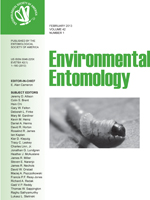Anoplophora glabripennis (Motschulsky) is an introduced invasive pest with the potential to devastate hardwood forests in North America. Using artificial pupal chambers, we documented the time required by teneral adults at three temperatures (20, 25, and 30°C), 60–80% RH, and a photoperiod of 16:8 (L:D) h to initiate boring after eclosion and subsequently bore completely through a 7-mm (range, 3–11 mm) layer of Norway maple wood (Acer platanoides L.). In total, 218 laboratory-reared pupae from the Chicago, IL, or Inner Mongolia, China, populations were used in the study. Females (1.54 ± 0.03 g) weighed significantly more than males (1.12 ± 0.03 g), but the average weights of the beetles emerging in each temperature did not differ. Adult weight was positively correlated with exit hole diameter (diameter [mm] = 2.2 * weight [g] 7.9). The rate at which beetles bored through the wood (136, 178, and 168 mm3/d at 20, 25 and 30°C, respectively) significantly differed between temperatures but did not differ with beetle weight. Temperature had a significant effect on the time it took adults to initiate boring (7, 5, and 4 d at 20, 25, and 30°C, respectively) and subsequently to complete boring to emerge (5, 4, and 4 d at 20, 25, and 30°C, respectively). This suggests that beetles require more than a week to progress from eclosion to emergence in wood, even at summer temperatures. This information on A. glabripennis basic biology is critical for developing phenology models that are used to time exclusion and eradication methodologies.
How to translate text using browser tools
1 February 2013
Development of the Teneral Adult Anoplophora glabripennis (Coleoptera: Cerambycidae) : Time to Initiate and Completely Bore Out of Maple Wood
V. Sánchez,
M. A. Keena
ACCESS THE FULL ARTICLE
It is not available for individual sale.
This article is only available to subscribers.
It is not available for individual sale.
It is not available for individual sale.

Environmental Entomology
Vol. 42 • No. 1
February 2013
Vol. 42 • No. 1
February 2013
Asian longhorned beetle
degree-days
development
invasive species
temperature




